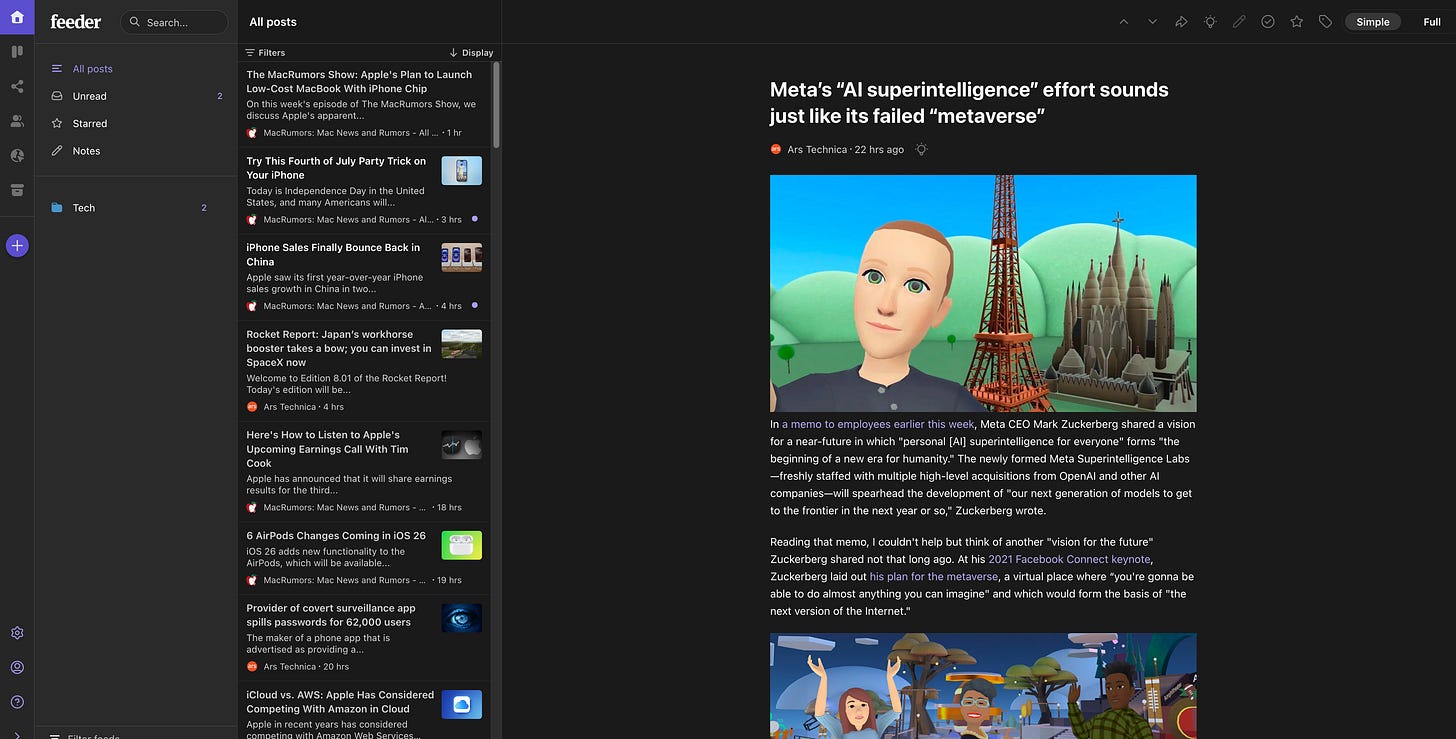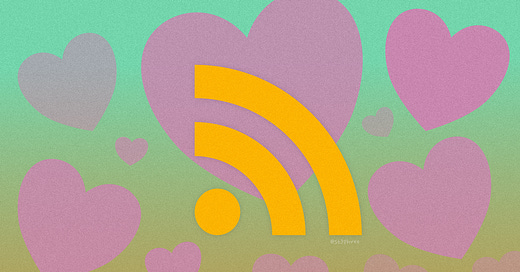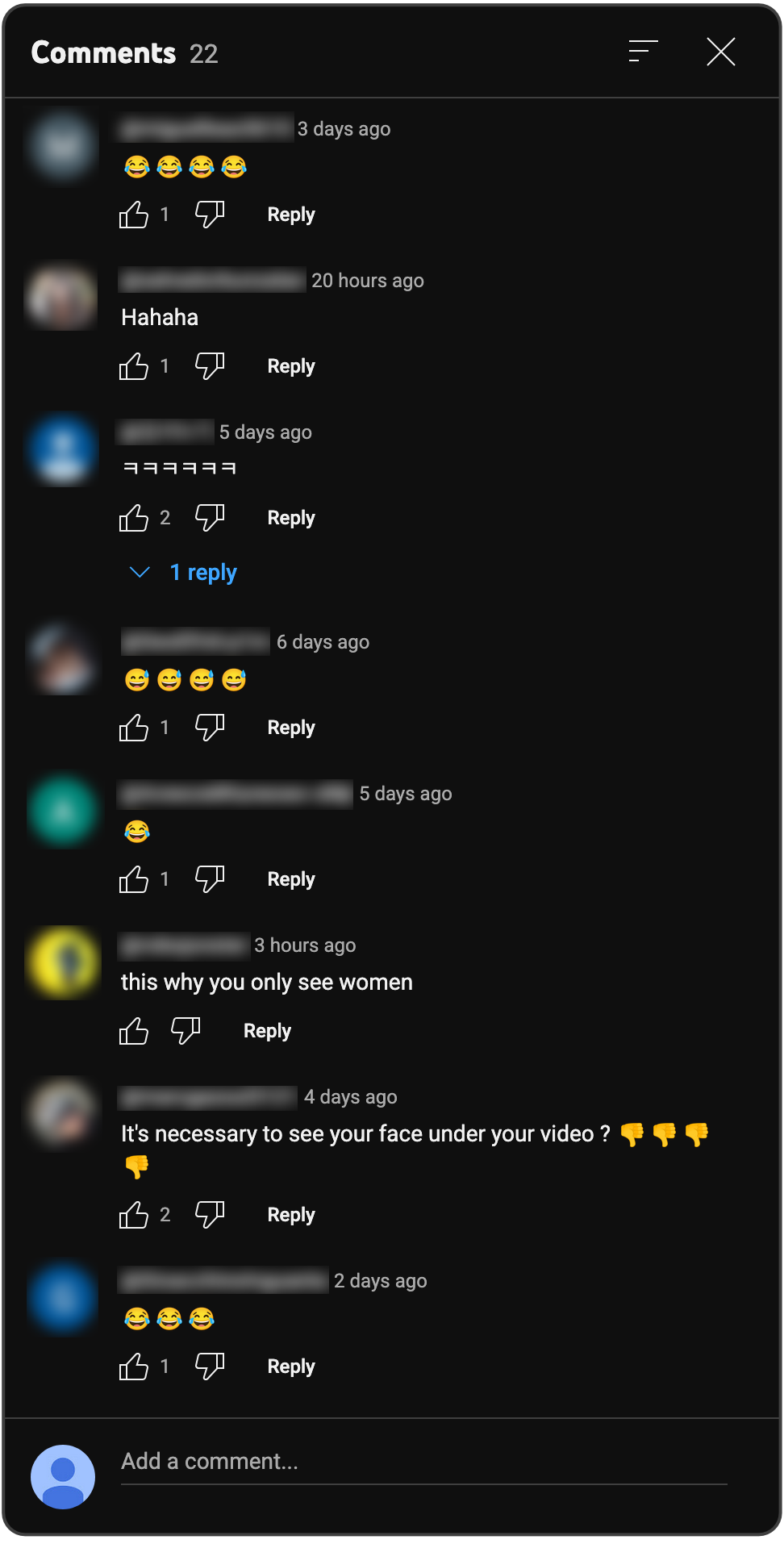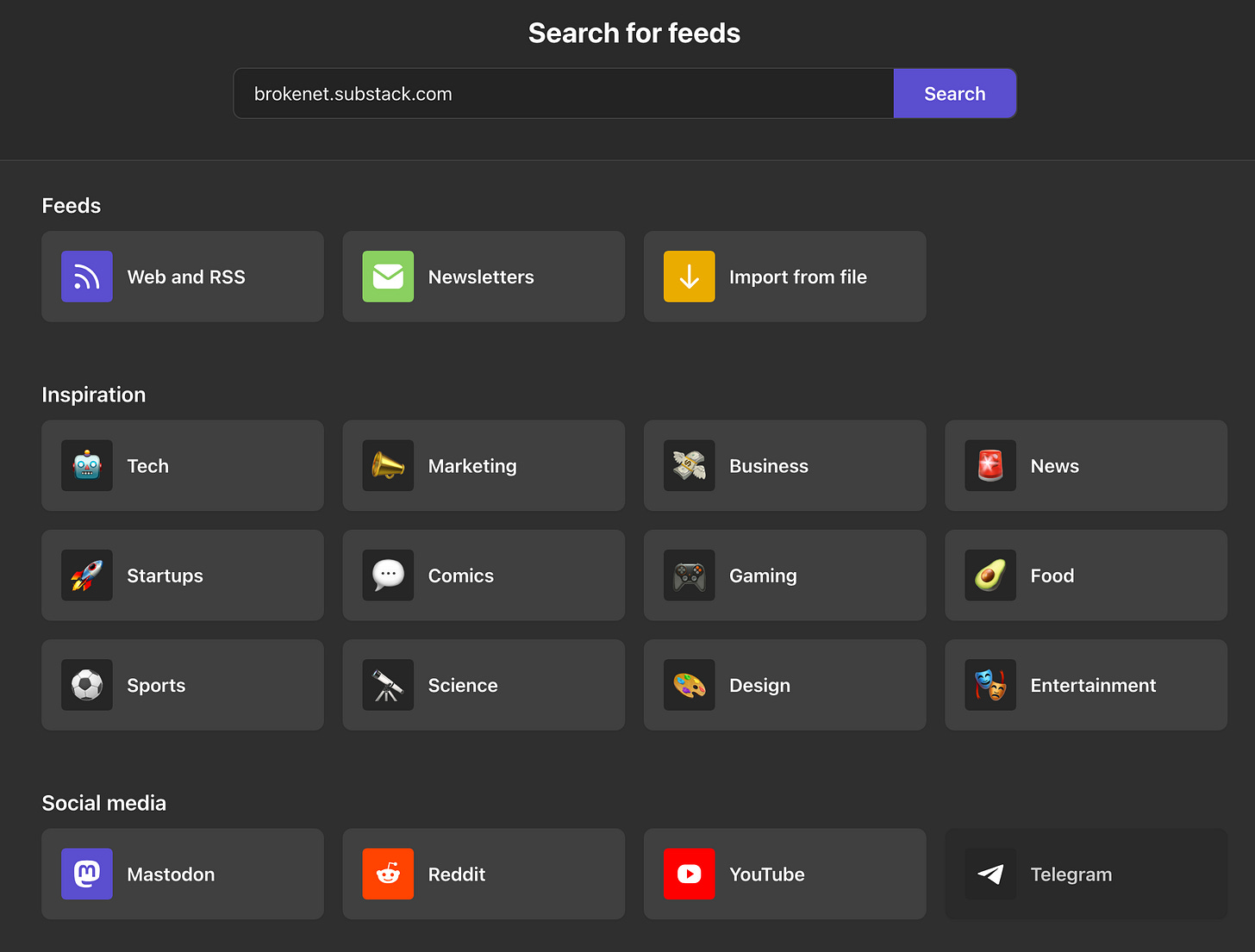Is it Time to Revisit RSS?
Given that people are increasingly fed up with the internet's enshittification, I argue that this "dead" technology still has potential and is worth a second look.
I want you to imagine, for a moment, an internet that isn’t dominated by privacy-disrespecting recommendation algorithms—one where you can curate and collate information that matters to you via one user interface, without enduring any of the standard background noise associated with enshittification. No annoying cookie pop-ups. No full-page ads. No unsolicited commentary from AI bots designed to spread misinformation, sow political dissent, and sell crappy products.
Well, people … try not to feel too depressed when I tell you that the above scenario might have been possible, had the chief architects of RSS stopped bickering long enough to fully realize their vision for an open and syndicated web.1
You’d be forgiven, of course, if your immediate reaction to that last sentence was to ask “the architects of what, now?” RSS is hardly a household name. You might know what it is—and you may even still use it today—if you identified as a “nerdy blogging type” in the early 2000s. Everyone else? Gather ‘round, because what I intend to do with this post is properly introduce you to RSS and make a case for its potential as a means of escaping an increasingly enshittified internet. And if you’re already a fan of RSS and know all about what it has to offer? Please consider giving this post a read anyway, as you might enjoy the bits where I take the piss out of social media.
What RSS Does, in a Nutshell

RSS—which either stands for “Really Simple Syndication” or “Rich Site Summary,” depending on historical context—functions as a delivery system for data written in Extensible Markup Language (XML). RSS essentially makes it possible for website developers to push new content out to any location that has been set up to process XML. End users like you and me can also subscribe to free RSS feeds via consumer-oriented readers that translate XML files into a readily viewable format.2

RSS readers should have revolutionized the internet, and arguably would have if they hadn’t emerged around the same time that social media was taking off. Social media, after all, did almost everything RSS readers could do—and then some. Andrew Chen touched on this in a 2013 post on the death of RSS. “Consumers,” he wrote, “love it when they can follow, view feeds, and create content, all on the same site.” He listed Twitter, Instagram, and Tumblr as examples of “integrated readers” that held much more appeal for end users than read-only RSS platforms.
Chen’s argument against RSS made sense in 2013, back when Web 2.0 still had that new car smell. What about the present day, though, when people increasingly yearn for the simplicity of the early internet? Search on DuckDuckGo for “I miss Web 1.0,” and you’ll find numerous examples of older internet users—and even younger ones who’ve only ever known a world with Web 2.0—waxing nostalgic for the internet of yore. Follow that up with a search for “I want to quit social media,” and you could spend literal days reading through the results.
I doubt the major players would ever release their official numbers, but if they did, I suspect they’d confirm what has been obvious for a few years now: the social media platforms that have captured public imaginations for so long are bleeding users daily. In the absence of something better than social media3, I suggest “dead” technology like RSS is in a prime position to make a comeback among those of us who can’t stand what our favourite online haunts have become.
What RSS Has to Offer in 2025
Let me be clear from the outset: RSS is not a panacea. It can’t mop up the bucket loads of AI slop spilling out all over the internet. It can’t kill the bot clouds hovering around comments sections like flies on a carcass. As far as that shit’s concerned, we’ve long since reached a point of no return.
What RSS can do, at least, is release us from the vice-like grip of recommendation algorithms. According to the Reuters Institute, 54% of people in the United States now get their news updates from social media platforms. That’s a problem, because social media platforms do not deliver information chronologically. You only see what the recommendation algorithm “thinks” you want to see, based on prior viewing and clicking habits, based on what’s trending, and based on other metrics that are never made clear. RSS feeds, conversely, show you new content as soon as it’s uploaded to the websites you consciously choose to follow. In short, when you use RSS, you are the one who decides if an article is worth reading—not some enigmatic algorithm.
Will you come across content that won’t interest you one bit without the “assistance” of recommendation algorithms? Yes, frequently, but adding friction to your daily scroll session is important if you don’t want to spend every waking hour online. Social media peddlers have a vested interest in locking you into their platforms forever, so they use their predatory algorithms and scarily-detailed user data profiles to feed you content they know you’ll enjoy looking at. As a vestige of Web 1.0—an internet that was much more focused on the free and open distribution of information—RSS was developed with very different goals in mind. Indeed, to quote the RSS Advisory Board:
As long as there are social media gatekeepers using engagement algorithms to decide what you can and can't see, there will be a need to get around them. When someone offers an RSS or Atom feed and you subscribe to it in a reader, you get their latest updates without manipulation.
Speaking of manipulation, RSS can also help you bypass all of the annoying ways in which web developers deliberately ruin user experience to trick you into clicking on stuff you’d rather not click on. I’m talking about things like those massive cookie opt-out menus that devs hurl at you in lieu of respecting your privacy in the first place, or those full-page ads and banners that wreak havoc on your ability to scroll through an article. RSS was built with simplicity in mind, so you won’t see any of that garbage in your reader (unless you want to, for some reason).

Another benefit of RSS is that it strips away all of the armchair editorializing that accompanies most links posted on social media platforms. And as for the comments sections? Those aren’t visible in RSS feeds, either.4 Contrary to what we may have thought about that two decades ago, this is a very good thing. Back when Web 2.0 was in its infancy, and each platform dutifully added in text fields so all and sundry could share their views with one another, I doubt anyone seriously thought the internet would turn into this:
… or this:
I personally returned to using an RSS reader earlier this year, and not seeing this shit anymore is such a relief. You don’t appreciate how utterly broken the internet is until you tune out the inane chatter of unhinged wingnuts and bots for a while. Trying to use the present day internet without an RSS reader feels a little like trying to read a newspaper with a deranged town crier screaming in your ear. Constantly.
Ultimately, what RSS has to offer us in 2025 is a bit of peace and quiet. I don’t know about you, but after spending the last two decades watching one of humanity’s most important technological achievements devolve into a “fucked to death pile of burning caca,”5 I’m ready for peace and quiet.
“Okay, okay, you’ve convinced me. How do I use RSS?”
Glad you asked! Step one is to sign up for a free reader. My husband prefers Feedly, while I’m partial to Feeder. The cool thing about RSS is that it can be used by literally any website or application that’s set up to process RSS feeds, meaning no one reader has a monopoly. There are a multitude of readers out there for you to try, so I would suggest you check out a few first before you make your decision.
Once you’ve chosen your reader, your next step is to manually populate it with RSS feeds. Even though RSS has been declared “dead” since 2010 or so, most major news organizations and blogs still publish RSS feeds to this day. You can find the URLs for these feeds by looking around for the RSS symbol on the sites you enjoy. If the site’s developers chose not to call attention to their feed, most readers can help you track down feed URLs via their search features. Some readers can even create custom feeds for sites that don’t publish any (though this can obviously be a bit buggy).
Your final step is to sit back and enjoy reading new content published on the websites you enjoy without distractions. As a caveat, not all websites will publish full-text feeds; some deliver truncated posts and force you to navigate to the site itself to see the full article (and, of course, all their lovely adverts). I have personally made it my mission to avoid rewarding any website that tries to negate the phenomenal user experience and privacy advantages offered by RSS readers, but that’s just me. I only follow truncated RSS feeds if I really like the author or publication and want to support them with my clicks and ad views.
Closing Thoughts
I fully acknowledge the irony of posting an article like this on Substack, which is itself becoming progressively enshittified. I’m aware that I’m just as reliant as anyone else is on the very same systems I criticize here. If you don’t subscribe to my newsletter and got here via the Substack app or website, then there’s a good chance you found this post sandwiched between two bland ChatGPT-generated Notes on “quiet living,” or beneath a photo of someone’s lunch. Believe me, I know that finding refuge from what the internet has become feels like a fool’s errand these days, unless you’re prepared to embrace going full-blown Luddite.
RSS does undeniably give you a little more control, though, at a time when we have very little—so I do hope this post will find its way to you one way or another. This is where I’d normally invite you to share your thoughts in the comments, but y’know what? I absolutely get it if you’d rather not. 🙂
Until next time.
I won’t go into the fascinating story of how and why RSS was developed, but if you’re interested in learning more about it, read this excellent article over on Two Bit History.
I don’t mention it in the body of this post to avoid muddying the waters too much, but it’s worth noting here that Atom is another type of XML delivery system that some websites use instead of RSS. There are a few minor differences between the two types of feeds. Since Atom works on most modern RSS readers and is functionally similar enough to RSS at the end user level, I don’t see the point in saying much more about it beyond that.
Apologies to all you GenAI enthusiasts out there, but talking with chatbots ain’t it.
You can, of course, still read the comments if you absolutely must by clicking on the link at the end of an article in your RSS reader. You can also view comments directly if your reader has the option, like Feeder does, to toggle between a simple XML view and a full site view (the latter of which embeds entire HTML-formatted pages in your reader).









Thank you for explaining to me in very simple terms what RSS does. I’ve known what it is, but never understood the purpose. Your article just helped me understand the “why” and how useful and important it can be to those of us who are sick of the ultra curated AI internet!
This is really good